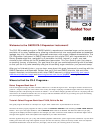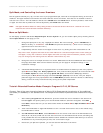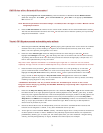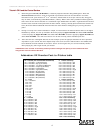OASYS CX-3 Modeled Tonewheel Organ Guided Tour
3
O
O
A
A
S
S
Y
Y
S
S
a
a
l
l
s
s
o
o
o
o
f
f
f
f
e
e
r
r
s
s
E
E
x
x
t
t
e
e
n
n
d
d
e
e
d
d
P
P
e
e
r
r
c
c
u
u
s
s
s
s
i
i
o
o
n
n
!
!
5. Staying with Program U-F-10, EX-Otones, press the small box of drawbars labeled EX Percussion.
(Alternate navigation: Press EXi1
> Press the Percussion tab > Press SW2 or the popup by Percussion:
Off to turn it on.
New: Notice the parameter Percussion Assign: In OASYS, either the Upper or Lower ‘Manual’ can be
assigned percussion!
6. Press the EX Percussion tab ‘Normal’ is the ‘volume fader’ drawbar for the entire EX Percussion section
>
The first two EX Percussion harmonics are fixed
> The last two take on whatever pitches you’ve previously
assigned to EX drawbars 1 and 2!
T
T
u
u
t
t
o
o
r
r
i
i
a
a
l
l
:
:
C
C
X
X
-
-
3
3
S
S
i
i
g
g
n
n
a
a
t
t
u
u
r
r
e
e
s
s
o
o
u
u
n
n
d
d
s
s
a
a
n
n
d
d
m
m
o
o
d
d
e
e
l
l
i
i
n
n
g
g
n
n
o
o
i
i
s
s
e
e
a
a
r
r
t
t
i
i
f
f
a
a
c
c
t
t
s
s
1. Select Program U-F-017, LS Dirty Funk > Without playing the keyboard, listen to the amount of modeled
artifacts in this ‘dirty’ sound, enabling it to capture all the audio aspects and funky taste of Dr. Lonnie
Smith, one of the premier jazz organists of our time!
2. Press the ‘Clean’ Wheel Type instead of Vintage and hear the noise change in character
> Press to
highlight the Leakage Level value
> Play and change this value to extremes and note the sonic accuracy
Try altering the Overtones level in the same way To hear the Overtone changes play a simple triad, or a
fifth on the keyboard while you vary the values.
Why This Is Cool: Adjacent tonewheels in a tonewheel organ might leak’ or ‘cross-talk’ into one another,
especially with age. The CX-3 model in OASYS captures every nuance of this electro-mechanical wear and tear.
3. Press the Noise Level parameter
> Bring the Noise Level down to 0, then gradually up to suit taste. > If
you’ve turned Percussion on with SW2, turn it off to more easily listen to the Key Click parameters
>
Highlight the Key-On Click Level and try different values > Leave it parked somewhere in the middle
range, around 50
> Now highlight the Key-Off Click Level > Exaggerate this value to 99: OASYS
generates two separate key clicks, one on the downstroke, and the second on the key release, accurately
modeling varying degrees of ‘dirty’ contact noise.
*SHORTCUT: Remember that any of these tweaks can immediately be written to the current
Program location simply by pressing the SEQ REC/WRITE key and pressing OK in response to the
question “Are You Sure”
1. Press the tab Amp/VC/Rotary SP and press the value field after Amp Type:. Type 2 was modeled after
the classic sound of an organ played through both a Rotary Speaker and a “British” guitar amp, as made
famous by rock organist Keith Emerson. This sound emphasizes more highs (visible in the EQ graph to the
right), and its overdrive characteristic becomes even more pronounced when you increase Amp Gain
>
Amp Gain has an AMS control assigned to it > Change the Intensity to about +60 and listen to the amp
‘dirty up’ as you play and slide on the ribbon towards the right: What a cool way to add emphasis to
certain notes or phrases as you solo!
2. Note that Vibrato/Chorus can be independently turned on and off for each Manual Also note that this
function can be assigned to a switch, or any other modulation source you like.
3. To the right is a column labeled ‘Preset’ (History: Tonewheel organs have a rotary knob that chooses one
of three speeds of vibrato or chorus
> OASYS not only faithfully captures these effects, but expands the
possibilities by allowing you to create your own effect speed, with your own modulator: Imagine having
velocity (normally disregarded by an organ) modulate the chorus speed, for example!






